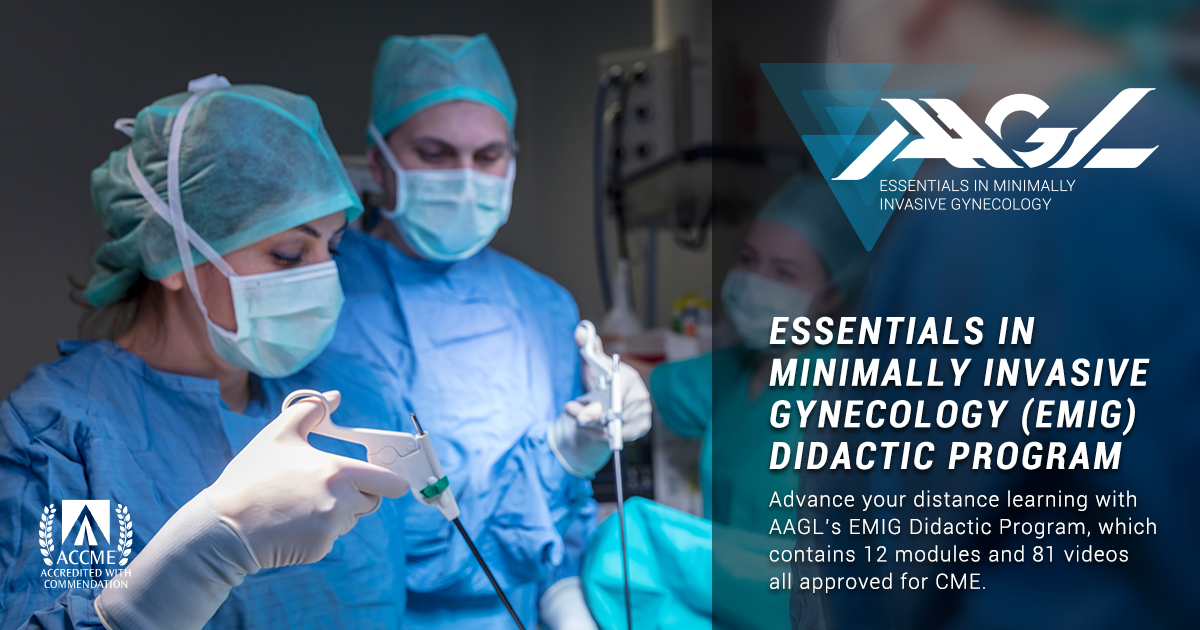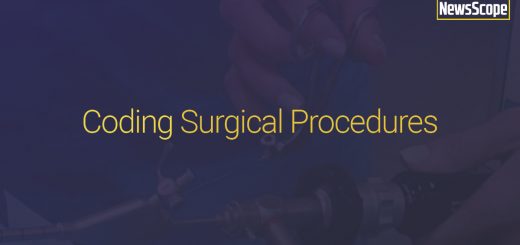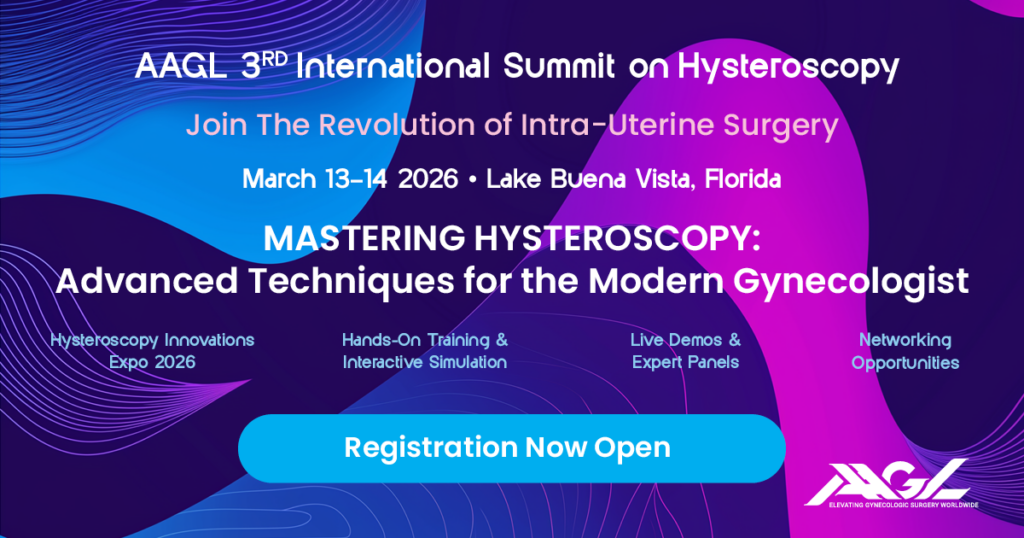EMIG: Continued Achievements

Prologue
The article below contains historical information on the creation of the Essentials in Minimally Invasive Gynecology (EMIG) program. This information was presented in the December 2020 Newscope and is included again in this article. As you read through the article, please note the continued achievements with the EMIG Cognitive examination completion and the launch of the EMIG Didactic Program.
History/Background
AAGL initiated the EMIG program to meet a need for standardized assessment of physicians performing minimally invasive gynecologic surgery (MIGS).
The techniques of laparoscopic and hysteroscopic surgery have expanded rapidly to effectively address a multitude of pathologies and procedures that were once unimaginable. However, a reproducible mechanism for teaching and evaluation of these skills has lagged, leading to the recognition that there is an urgent need for more objective assessment of surgical skills and competencies. It has become clear that the old adage “See one, Do one, Teach one” is no longer an acceptable model for surgical education and that simulation can provide tremendous preparation of our trainees before participating in surgery.
Why did AAGL create EMIG?
The limited duty hours and available resources in residency education, with an ever-expanding body of knowledge and surgical approaches have led to inconsistency in training for our residents in MIGS. These factors, together with the lack of a standardized curriculum and a consistent and validated mechanism for measuring the proficiency and skill of the individual surgeon, led the AAGL to undertake the development of a standardized laparoscopic as well as hysteroscopic simulation protocol. EMIG manual skills modules were created for training as well as standardized assessment. These were combined with a comprehensive didactic curriculum and a Gyn-specific cognitive exam. Existing laparoscopic simulation programs had been developed by general surgeons for general surgery trainees, with didactics largely irrelevant for gynecologists, and a lack of hysteroscopic simulation and assessment.
The AAGL contracted with a psychometrician and created a steering committee of Subject Matter Experts to aid in the development process. The psychometrician worked closely with the AAGL steering committee to provide guidance throughout the process, using best practices established by professional testing standards and guidelines. Following a rigorous 10-step program outlined by the group, the AAGL developed a validated cognitive test. A similar process was used to develop measurable hysteroscopic and laparoscopic skill exercises that test the unique psychomotor skills needed for MIGS. The skill exercises were validated to determine that they reliably differentiate minimally proficient surgeons from highly proficient surgeons. AAGL has completed the 2nd beta testing program that serves as a prelude to a national validation testing process. This construct validation study evaluated trainees and gynecologic surgeons distributed among 3 levels of proficiency in several regions of the United States, to account for regional training variations. Simulators were also specifically designed to simulate pelvic and hysteroscopic surgery. This work has produced two assessments – one cognitive, and one psychomotor skill- based, and both have been validated to measure the knowledge and technical skills of the aspiring MIGS surgeon.
Cognitive Examination
EMIG Cognitive Exam was designed to test basic knowledge of laparoscopy, hysteroscopy, electrosurgery, and complications. The exam will be delivered via a web-based testing platform that uses remote proctoring via webcam.
The Cognitive Blueprint consists of 12 subject areas that comprise a total of 88 objectives defined by Subject Matter Experts and evaluated by way of surveying 300 gynecologic surgeons. The Cognitive exam just completed its final stages of validation and the cut score for the exam has been set.
EMIG Didactic Program
The EMIG web based didactic content was launched in March, and we are seeing a great demand for viewing the training modules. The EMIG Didactic Program consists of twelve video modules, with a total of eighty narrated videos, built from the EMIG cognitive exam blueprint. The EMIG didactic content has been certified for 10.5 hours of CME credits. The videos are delivered in high definition and are available for purchase on AAGL’s website. This is the only such educational offering of its kind with laparoscopy, hysteroscopy, electrosurgery and complications content. A summary of the twelve video modules includes:
Module 1: General Endoscopic Principles
Module 2: Applied Anatomy and Physiology
Module 5: Operating Room/Equipment Set Up
Module 6: Laparoscopy Specifics
Module 7: Hysteroscopy Specifics
Module 8: Laparoscopy Procedures
Module 9: Hysteroscopy Procedures
Module 10: Laparoscopy Complications
Module 11: Hysteroscopy Complications
Module 12: Special Considerations
AAGL is planning to develop two additional modules to address Hysterectomy and Office Based Procedures.
What’s Next for EMIG?
EMIG is one of AAGL’s most ambitious endeavors. This year has truly been a banner year. Providing temporary access of our video curriculum in MIGS to over 300 residents, completing the validation and 2nd beta cognitive exam and releasing our EMIG Didactic Program have been critical milestones in moving forward. EMIG sets the standard for training and evaluation in gynecologic laparoscopy and hysteroscopic surgery. The next steps include making the program available for virtual proctoring and testing of our fellows and residents, potentially adding an integral component of manual skills assessment to our residency training programs and offering an assessment tool and recognition of surgical skills for our international colleagues.
Future directions include translation and cultural adjustments of the didactic content and cognitive test, to make the EMIG test available for our colleagues worldwide.
The EMIG Steering Committee aims to build a mechanism for recruiting research proposals, create an expert review process and solicit potential grant funding, for aspiring fellows and members to strengthen the body of evidence of EMIG.
As we continue to make strides in the EMIG validation process, the EMIG Steering Committee will guide the business development of the EMIG program, following through on the AAGL Executive Board’s recommendations for implementation of the EMIG Cognitive Exam, Curriculum, and Skills Test. We are reaching our EMIG goals and soon it will be time to celebrate!
We are grateful and most appreciative for the countless hours and dedication of the AAGL members and staff who have contributed to EMIG and without whom none of this tremendous progress could have been achieved.






